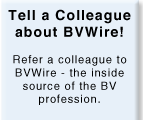
BVR approved as CFA continuing education credit provider BVR was just approved as a member of the CFA Institute’s Approved-Provider Program—a very elite group of CPE providers. Attendees of most BVR webinars and live events will be eligible to receive continuing education credits issued by the CFA Institute. Click here for more information on upcoming BVR education events. What is the best holding period in Chris Mercer’s QMDM? Another attendee challenged any one to defend how they would support a 2 year (as in the FMV Restricted Stock Study), 5 year, or 13 year holding period. Lurie said, for instance, that if a majority shareholder is 52 and likely to sell at 65, then an argument could be made for a 13 year holding period. He was confronted by another attendee who said “that’s true but there’s a chance the owner could die tomorrow, so what do you do then?” ”It’s up to us to defend our choice, whatever we conclude,” Yeanoplos concluded, trying to move beyond this complicated “speed bump” for the appraisal profession. NACVA/IBA attendees debate whether there’s such a thing as a “key person discount?”It makes sense that a closely held business would be worth less when the key person is no longer going to be part of the business. In fact, this is often the case when the valuation is being performed for an estate when the decedent was the key person in the business. But, “there’s really nothing in the literature that really supports this,” a NACVA member commented. And, a “key person discount” would have to cover many variables. There can be a business where a 10% owner controls all five of the major accounts. Or, there can be cases where two 50% owners would have different discounts if they were no longer in the business. Most attendees at the NACVA/IBA session on adjustments to company financials said they felt more comfortable trying to account for this factor by adjusting either the income stream, or the company specific risk component of the discount rate. “Judges do not generally like company specific risk,” says Gary Trugman (Trugman Valuation Associates). “That’s where I’d like to put the impact of losing a key person, but sometimes this decision can increase the likelihood that your valuation is challenged at some point. Another concern that many appraisers see regularly: the key person hires you, but they’re not as “key” as they think they are. Trugman said “we’ve all seen businesses where the key person has stalled growth. The kids or next generation takes over and suddenly it’s like you’re on a rocket ship. In those cases, should we take a key person premium?” You need to meet all the managers and potential managers to make a correct assessment, Trugman says:
Key person situations play a role in competitive analysis too; death isn’t the only form of separation that can influence value conclusions. Often the key person leaves–only to open their own doors across the street as a competitor. Thornhill update: Colorado confirms marketability discounts in divorce, despite ‘value to the owner’ standard First the Colorado family court accepted a 33% marketability discount for a controlling (70%) interest in a $1.7 million oil and gas operation (see BVWire #72-2). Then just last September, the appellate court confirmed the valuation—and rejected the wife’s argument that discounts should be precluded when valuing marital assets for divorce, as they are in statutory fair value cases in Colorado (see BVWire # 84-4). The wife appealed the decision again, and just last week the state’s highest court had the final say:
“This is big news for Colorado family law,” says Ron Seigneur (Seigneur Gustafson). “Fair market value now ‘works’ in divorce cases, in addition to value to the owner, at the courts’ discretion, so it will create some interesting battles between experts,” clients and counsel. “Colorado changes its place on the continuum,” comments Jay Fishman (Financial Research Associates, and co-chair of the BVR/Morningstar 3rd Annual Summit on Business Valuation in Divorce on Sept. 13-14 in Chicago.). What remains to be seen: whether the Colorado decision opens the door to marketability discounts in states with broad, equity-based or other “discretionary” standards of value. Read the complete digest of IRM Thornhill in the next Business Valuation Update™; the Colo. Supreme Court’s opinion will be available soon at BVLaw™. New ASA Business Valuation Committee leadership
All the cases you need to read on the discount rate in damages calculations, and more The item in the last BVWire on “the power of the discount rate” prompted numerous subscriber inquiries and requests for the “dirty dozen” cases on determining the discount rate in economic damages cases. Although a few of the opinions are too old (pre-Internet era, circa 2000) to be posted online, we did a search of BVLaw and found two very recent bankruptcy cases to add to the list, for a total of 14 “must read” decisions for appraisers and attorneys alike. A full write-up of all the decisions—including the competing expert determinations and the courts’ ultimate holdings—will appear in August, 2010 Business Valuation Update™. In the meantime, the cases are:
Where can you get even more authority on developing the discount rate? Look for The Comprehensive Guide to Lost Profits Damages For Experts and Attorneys, 2010 Edition, by noted expert and author Nancy Fannon (Fannon Valuation Group). Newly updated and expanded, the 2010 edition contains two chapters on developing the discount rate (in valuation practice and in case law), plus chapters on the reasonable certainty standard, calculating damages for early-stage companies; patent infringement and trademark damages; special considerations for measuring lost profits in physician practices, and more. Contributors included Neil Beaton (Grant Thornton), Mark Dietrich, Prof. Robert Lloyd (Univ. Tenn. School of Law), plus notable financial experts and attorneys. The 2010 Comprehensive Guide to Lost Profits will be available this summer at BVResources.com. A simple practice management reminder: accept credit cards BVR’s most recent Business Valuation Firm Economics and Best Practices Survey suggested that over half of BV firms accept credit cards as a way to accelerate cash collection and reduce billing disputes or writeoffs. Ron Seigneur, who was speaking at the NACVA/IBA Conference in Miami last week, advised all BV firms to “go down to Wells Fargo or whatever bank they use and sign up for merchant services.” Ron is a founder of Y&S Advisory Services, which helps appraisers and lawyers with quality control, report review, training, and other practice development initiatives. PS: BVR will update its biennial Firm Economics Survey later this summer. If you’d like to participate (and receive the participant’s discount), send us an email. New TAF Appraisal Practices Board to commence July 2010 Of the 125 applicants for the new Appraisal Practices Board, two appointed members are BV members, Jay Fishman (Financial Research Associates) and Alok Mahajan (KPMG). Fish was appointed vice chair. The mandate of this new group:
Healthcare reform and its impact on valuation Next week on Thursday June 10, join healthcare valuation specialists Don Barbo (Deloitte Financial Services), Elliott Jeter (VMG Health), and Mark Dietrich for “Healthcare Reform and its Impact on Valuation.” In this 100-minute webinar, the three experts will discuss the effects healthcare reform and related legislation will have on your value conclusions. To find out more or to register, click here. Two CPE credits are available. IVSC publishes new “International Valuation Standards” exposure draft On June 2nd, the International Valuation Standards Council (IVSC) published an Exposure Draft of new proposed “International Valuation Standards”. The new standards address the valuation of most types of assets in addition to a new proposed standard for financial instruments. The IVSC invites comments invite comments through September 3, 2010 and plans to publish the new standards in January 2011. The Exposure Draft is available here. Free FASB webinar on accounting for financial instruments FASB is offering a free, interactive webcast on the Proposed Accounting Standards Update, Accounting for Financial Instruments and Revisions to the Accounting for Derivative Instruments and Hedging Activities on June 30, 2010. Panelists and FASB members Marc Siegel, Russ Golden, and Kevin Stoklosa will provide an overview of the Proposed Accounting Standards Update, which “seeks to bring more transparency into financial statements by incorporating both amortized cost and fair value information about financial instruments held for collection or payment of cash flows." To register, click here. One optimistic M&A analyst predicts a “coming tidal wave” of mid-market deals Quoting a PriceWaterhouseCoopers study, Dennis Roberts (The McLean Group) told NACVA/IBA conference attendees that 67.7% of all middle market business owners are baby boomers--and 83% of these business will be sold. Who will be buying? Roll-up groups, industry consolidators, private equity groups and non-US buyers, according to Roberts. The top five industries seeing the most M&A in 2010 are banking, healthcare, financial services, information technology, and energy. Fair Value or Historical Cost Reporting: The Debate Continues Edward Reidl (Harvard University) told NACVA/IBA conference attendees that there is still a “great debate” between fair value and historical cost, even though fair value reporting has historical underpinnings dating back to the 1920’s. Reidl outlined the pros and cons of fair value: Fair Value Pros:
Fair Value Cons:
Reidl noted that we have been, and probably will continue to be, under a mixed attribute model, which means we have some fair value and some historical cost. “The appropriate question to ask is not ‘either/or’; it is ‘how much,’” says Reidl. There has been an increase of fair value in financial reporting, and Reidl believes it will continue to grow. His “bold (and maybe not so bold) predictions for the next 5 years,” are listed in the table below.
To ensure this email is delivered to your inbox, Copyright © 2010 by Business Valuation Resources, LLC
|
|




